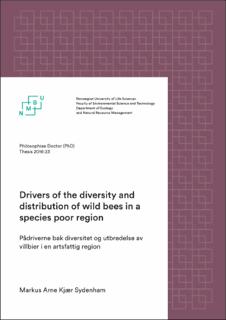| dc.description.abstract | Bee diversity is declining globally. On a European scale, roughly 10% of the species are considered threatened, but the number may be even higher. The threatened status of bees depends on both the taxonomic and spatial scale. For instance, a relatively high proportion of species within the cold adapted Bombus are expected to decline due to global warning. Moreover, numbers may differ among regions and about 25% of the bee species in Norway are considered threatened. Halting or reversing this decline requires that we understand the main drivers of bee diversity within regions. Species-poor regions where the autecology of species are relatively well known may provide valuable model systems for studying the processes behind community assembly. Indeed, due to the low numbers of species and steep environmental gradients one may expect a relatively rapid species turnover over short geographic distances in Norway.
The aim of this thesis was to identify important drivers of bee diversity in Norway. Bee-flower networks from different regions of the world were used to test for the influence of global scaled processes on community assembly (Paper I). We tested if the phylogenetic turnover among Bee-flower networks (i.e. bee communities) increased with geographic distances, thus indicating an influence of speciation and migration, and with dissimilarities in climatic conditions, thus indicating global ecological filtering. We also tested if the niche overlap, in terms of visitations to plant species, was determined by the bee phylogeny, thus indicating within community ecological filtering. We used bee communities sampled in power line clearings surrounded by boreal forests as model systems for studying the influence of dispersal limitation, ecological filtering and ecological drift on the distribution of species within the metacommunity (Papers II-V). We established an experiment within this system to test how, and under which conditions, different management practices could improve power line clearings for wild bees (Paper IV). | nb_NO |
